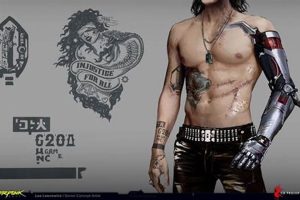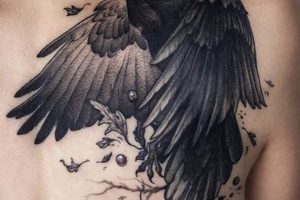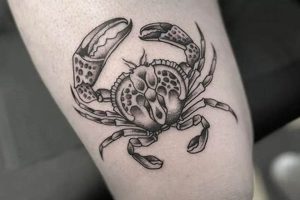Large canvas body art concepts for the back offer a wide range of creative possibilities, from intricate full-back pieces to smaller, more delicate designs situated on the upper or lower back. Examples include depictions of nature scenes, animals, abstract patterns, spiritual symbols, or textual elements.
The back’s expansive and relatively flat surface provides an ideal location for detailed and complex artwork. This body area also allows for discretion, as the designs can be easily concealed with clothing. Historically, back tattoos have held cultural significance in various societies, representing status, beliefs, or group affiliation. Today, they continue to be a popular choice for self-expression and artistic storytelling.
Exploration of specific design styles, placement considerations, aftercare practices, and the artist selection process will provide a comprehensive understanding of the subject. This will empower individuals to make informed decisions about their body art and achieve desired aesthetic outcomes.
1. Placement (upper, lower, full)
Placement is a fundamental consideration in back tattoo design, significantly influencing the visual impact and overall composition. The back’s large canvas offers diverse placement options, each presenting unique aesthetic opportunities and practical implications. Careful selection of location ensures the design harmonizes with the body’s contours and effectively conveys the intended message.
- Upper Back
The upper back, encompassing the shoulders, spine, and area between the shoulder blades, provides a prominent and relatively flat surface suitable for detailed designs. Popular choices include symmetrical patterns, wings, or large-scale artwork spanning the entire width of the back. The visibility of upper back tattoos makes them ideal for bold statements and intricate compositions.
- Lower Back
The lower back, curving towards the hips, offers a more sensual and discreet canvas. Smaller designs, such as floral motifs, tribal patterns, or script, are often favored in this area. The lower back’s curvature can be incorporated into the design, creating a flowing and dynamic aesthetic. Placement here also allows for easier concealment when desired.
- Full Back
Full back tattoos represent the ultimate commitment, utilizing the entire back as a single canvas for a grand, cohesive artwork. These designs often incorporate complex narratives, intricate details, and multiple elements that work together to create a visually stunning masterpiece. Full back pieces offer unparalleled opportunities for artistic expression but require significant planning and multiple sessions.
- Shoulder Blade/Spine
Focusing a design specifically on a shoulder blade or along the spine presents a unique opportunity to highlight these anatomical features. Elongated designs, such as feathers, branches, or abstract lines, can complement the natural curves of these areas. These placements offer a balance between visibility and discretion, suitable for both bold and subtle aesthetics.
Strategic placement choices contribute significantly to the success of back tattoos, enhancing their aesthetic appeal and personal significance. Considering factors such as body shape, design size, and desired level of visibility ensures a harmonious and impactful result. By understanding the unique characteristics of each placement area, individuals can make informed decisions that complement their artistic vision and personal style.
2. Design style (realistic, tribal, etc.)
Design style selection is paramount when conceptualizing back tattoos, significantly impacting the final aesthetic and conveying specific meanings. The expansive canvas of the back provides ample space for diverse styles, ranging from highly detailed realism to bold geometric patterns. Understanding the nuances of various styles allows for informed decisions aligned with individual preferences and desired symbolism.
Realistic designs, often depicting portraits, animals, or nature scenes, require a high level of artistic skill and technical precision. The back’s large surface area allows for intricate details and lifelike representations. Tribal styles, characterized by bold black ink and geometric patterns, often hold cultural significance and represent ancestral heritage. Japanese traditional designs, incorporating elements like koi fish, dragons, and cherry blossoms, offer vibrant color palettes and symbolic narratives. Geometric patterns, utilizing precise lines and shapes, create visually striking and abstract compositions. Script tattoos, featuring meaningful quotes or names, allow for personalized expressions in various fonts and calligraphy styles. The chosen style influences the overall impact and longevity of the tattoo, requiring careful consideration of personal aesthetics and the artist’s expertise.
Selecting an appropriate design style is crucial for achieving desired outcomes. Factors such as personal preferences, cultural background, and the tattoo’s intended meaning should inform the decision-making process. Consulting with experienced tattoo artists specializing in the preferred style ensures a successful and aesthetically pleasing result. Careful consideration of design style contributes significantly to the creation of meaningful and visually impactful back tattoos.
3. Scale and complexity
Scale and complexity are integral considerations in back tattoo design, significantly impacting the visual impact, required time commitment, and overall cost. The back’s expansive area allows for designs ranging from small, minimalist pieces to large, intricate murals. Careful evaluation of these factors ensures a harmonious balance between artistic vision and practical constraints.
- Size and Coverage
Size directly influences the visual prominence of the tattoo. Smaller designs offer subtlety and discretion, while larger pieces create bold statements. Coverage, referring to the proportion of the back utilized, ranges from isolated elements to full back pieces. A small floral design on the upper back offers a different aesthetic impact compared to a large, intricate dragon spanning the entire back. Choosing the appropriate size and coverage ensures the design complements the individual’s body and desired level of visibility.
- Detail and Intricacy
The level of detail and intricacy within the design dictates the time required for completion and the artist’s skill level. Highly detailed designs, such as photorealistic portraits or complex mandalas, necessitate multiple sessions and specialized expertise. Simpler designs, featuring clean lines and minimal shading, can be completed more quickly. Balancing detail with practicality ensures a manageable process and a visually satisfying outcome.
- Time Commitment and Cost
Larger, more complex designs require significantly more time to complete, often necessitating multiple sessions spanning several hours each. This extended time commitment translates to a higher overall cost, as tattoo pricing is typically based on hourly rates or project complexity. Realistically assessing the time and financial investment required for the desired scale and complexity is crucial for a positive experience.
- Visual Impact and Cohesion
The scale and complexity of a back tattoo directly contribute to its overall visual impact. Large, intricate designs command attention and serve as powerful forms of self-expression. Smaller, simpler designs offer a more understated elegance. Maintaining visual cohesion and balance is essential, regardless of scale. A well-executed design, whether simple or complex, will appear harmonious and aesthetically pleasing.
Understanding the interplay between scale, complexity, and practical considerations allows for informed decisions and successful back tattoo experiences. Careful planning and open communication with the chosen artist ensure the final result aligns with individual preferences, budget, and desired aesthetic. By thoughtfully considering these factors, individuals can embark on the journey of creating meaningful and visually impactful back tattoos.
4. Pain tolerance considerations
Pain tolerance is a critical factor when considering back tattoos. Discomfort levels vary significantly based on individual sensitivity and specific locations on the back. Understanding these variations and employing appropriate management strategies contributes to a more positive and manageable tattooing experience.
- Individual Sensitivity
Pain perception is subjective, influenced by individual pain thresholds and overall sensitivity. Factors such as previous tattoo experience, general health, and emotional state can influence discomfort levels. Open communication with the tattoo artist regarding pain concerns allows for personalized adjustments during the process.
- Location on the Back
Certain areas of the back are more sensitive than others due to nerve density and proximity to bone. The spine, ribs, and shoulder blades are generally considered more sensitive areas. Conversely, the upper and lower back muscles tend to be less sensitive. Placement choices should consider these variations to minimize discomfort.
- Pain Management Techniques
Various techniques can help manage discomfort during tattooing. Deep breathing exercises, meditation, and listening to music can offer distractions and promote relaxation. Over-the-counter pain relievers, such as ibuprofen, may be used prior to the session, but aspirin should be avoided due to its blood-thinning properties. Numbing creams, applied topically before the procedure, can also provide temporary relief.
- Session Length and Breaks
Extended sessions can exacerbate discomfort. Breaking down large designs into multiple shorter sessions allows for rest periods and reduces overall pain accumulation. Open communication with the artist allows for scheduled breaks as needed, contributing to a more manageable experience.
Careful consideration of pain tolerance, including individual sensitivity and location-specific variations, is essential for a positive tattoo experience. Employing appropriate pain management techniques and maintaining open communication with the artist ensures a comfortable and successful outcome, enabling individuals to fully enjoy the process of creating their desired back tattoo.
Tips for Back Tattoo Designs
Successfully realizing impactful body art concepts for the back requires careful planning and consideration. The following tips provide valuable insights into the process, enhancing decision-making and ensuring satisfactory outcomes.
Tip 1: Research and Inspiration: Thorough research is paramount. Exploring various design styles, artists’ portfolios, and symbolic representations ensures informed choices aligned with personal aesthetics and desired meanings. Curating a collection of inspirational images helps refine the vision and facilitates effective communication with the tattoo artist.
Tip 2: Artist Selection: Choosing a skilled and reputable artist specializing in the preferred style is crucial. Reviewing portfolios, seeking recommendations, and scheduling consultations allows for assessment of artistic expertise and compatibility. A strong artist-client relationship fosters clear communication and contributes to a successful outcome.
Tip 3: Placement Considerations: Careful placement optimizes the design’s impact and complements the body’s natural contours. Upper, lower, or full back placements offer distinct aesthetic opportunities. Placement should consider the design’s size, shape, and desired level of visibility.
Tip 4: Scale and Complexity: Design scale and intricacy influence both visual impact and practical considerations. Larger, more complex designs require multiple sessions and a greater time commitment. Balancing artistic vision with practical constraints ensures a manageable process and a satisfying result.
Tip 5: Pain Management: Acknowledging potential discomfort and employing appropriate management strategies enhances the overall experience. Understanding variations in sensitivity across different areas of the back, combined with techniques like deep breathing and numbing creams, contributes to a more comfortable process. Open communication with the artist regarding pain concerns facilitates personalized adjustments during the sessions.
Tip 6: Aftercare Commitment: Proper aftercare is crucial for preserving the tattoo’s vibrancy and preventing complications. Following the artist’s instructions regarding cleaning, moisturizing, and sun protection ensures optimal healing and long-term aesthetic preservation. Diligent aftercare demonstrates respect for the artwork and the body.
Tip 7: Budget Planning: High-quality tattoos represent a financial investment. Researching artist rates, estimating the required sessions, and establishing a budget facilitates responsible planning and prevents financial strain. Understanding the cost implications upfront contributes to a positive and stress-free experience.
By adhering to these guidelines, individuals can navigate the process of acquiring body art for the back with confidence, resulting in a meaningful and aesthetically pleasing outcome that reflects personal style and artistic vision.
These considerations empower informed decisions, fostering a collaborative journey with the chosen artist and culminating in a successful and personally meaningful expression of body art.
Frequently Asked Questions about Back Tattoos
Addressing common inquiries regarding back tattoos provides clarity and facilitates informed decision-making. The following questions and answers offer valuable insights into various aspects of the process.
Question 1: How long do large back pieces typically take to complete?
Completion time varies significantly based on design complexity, size, and individual artist’s pace. Large, intricate designs often require multiple sessions, potentially spanning several months or even years to allow for proper healing between sessions.
Question 2: Are certain back areas more painful to tattoo than others?
Areas with thinner skin and closer proximity to bone, such as the spine, ribs, and shoulder blades, tend to exhibit higher sensitivity. Areas with more muscle mass, like the upper and lower back, are generally less painful.
Question 3: How much do large back tattoos typically cost?
Cost depends on factors such as artist’s experience, hourly rate, design complexity, and overall time required. Large back pieces represent a significant investment, often ranging from several hundred to several thousand dollars.
Question 4: What is the best way to find a reputable tattoo artist for a back piece?
Thorough research is essential. Recommendations from friends or online communities, reviewing artist portfolios, and scheduling consultations are valuable steps in finding a skilled artist specializing in the desired style.
Question 5: What is the healing process like for a back tattoo?
Healing typically takes several weeks. Proper aftercare, including regular cleaning, moisturizing, and avoiding sun exposure, is crucial for preventing infection and ensuring proper pigment retention. Specific aftercare instructions should be provided by the tattoo artist.
Question 6: Can back tattoos be covered up or removed if needed?
While clothing can easily conceal back tattoos, complete removal requires laser treatments. Laser removal is a multi-session process with varying degrees of success depending on ink color, skin type, and tattoo age.
Careful consideration of these frequently asked questions provides a more comprehensive understanding of the process, enabling individuals to make informed decisions about their back tattoo endeavors. Further consultation with a chosen artist allows for personalized guidance and addresses specific concerns.
Exploring various design options and aftercare practices will further enhance the decision-making process and contribute to a successful tattoo experience.
Back Tattoo Ideas
Body art concepts for the back represent a significant form of self-expression, offering a large canvas for diverse artistic styles and personalized narratives. Careful consideration of placement, design style, scale, complexity, and pain tolerance is essential for achieving desired aesthetic outcomes. Strategic planning, thorough research, and collaboration with a skilled artist contribute significantly to the success and longevity of these impactful designs. Proper aftercare practices ensure vibrant color retention and prevent complications, preserving the artistic integrity of the chosen design.
The enduring popularity of large canvas body art reflects its capacity to embody personal narratives, cultural affiliations, and artistic visions. Thorough exploration of available design options and a commitment to responsible decision-making empower individuals to embark on this transformative journey with confidence, resulting in a powerful and enduring form of self-expression.







